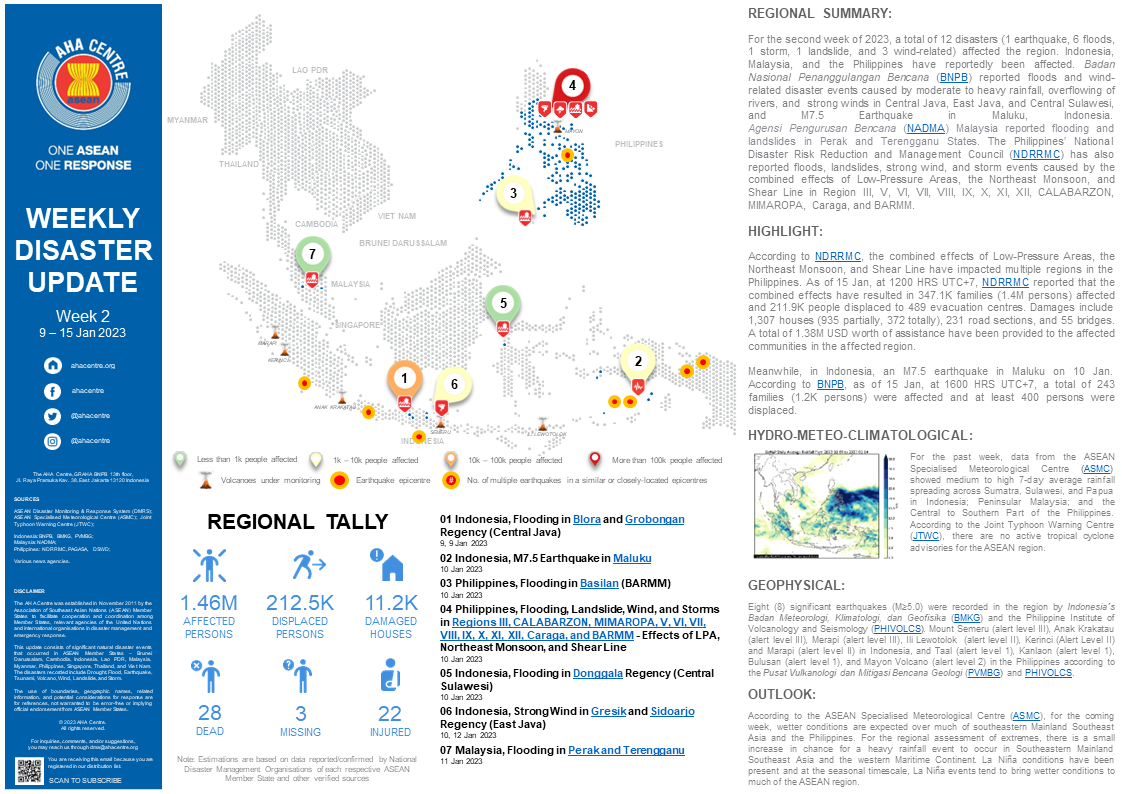
REGIONAL SUMMARY:
For the second week of 2023, a total of 12 disasters (1 earthquake, 6 floods, 1 storm, 1 landslide, and 3 wind-related) affected the region. Indonesia, Malaysia, and the Philippines have reportedly been affected. Badan Nasional Penanggulangan Bencana (BNPB) reported floods and wind-related disaster events caused by moderate to heavy rainfall, overflowing of rivers, and strong winds in Central Java, East Java, and Central Sulawesi, and M7.5 Earthquake in Maluku, Indonesia. Agensi Pengurusan Bencana (NADMA) Malaysia reported flooding and landslides in Perak and Terengganu States. The Philippines’ National Disaster Risk Reduction and Management Council (NDRRMC) has also reported floods, landslides, strong wind, and storm events caused by the combined effects of Low-Pressure Areas, the Northeast Monsoon, and Shear Line in Region III, V, VI, VII, VIII, IX, X, XI, XII, CALABARZON, MIMAROPA, Caraga, and BARMM.
HIGHLIGHT:
According to NDRRMC, the combined effects of Low-Pressure Areas, the Northeast Monsoon, and Shear Line have impacted multiple regions in the Philippines. As of 15 Jan, at 1200 HRS UTC+7, NDRRMC reported that the combined effects have resulted in 347.1K families (1.4M persons) affected and 211.9K people displaced to 489 evacuation centres. Damages include 1,307 houses (935 partially, 372 totally), 231 road sections, and 55 bridges. A total of 1.38M USD worth of assistance have been provided to the affected communities in the affected region. Meanwhile, in Indonesia, an M7.5 earthquake in Maluku on 10 Jan. According to BNPB, as of 15 Jan, at 1600 HRS UTC+7, a total of 243 families (1.2K persons) were affected and at least 400 persons were displaced.
HYDRO-METEO-CLIMATOLOGICAL:
For the past week, data from the ASEAN Specialised Meteorological Centre (ASMC) showed medium to high 7-day average rainfall spreading across Sumatra, Sulawesi, and Papua in Indonesia; Peninsular Malaysia; and the Central to Southern Part of the Philippines. According to the Joint Typhoon Warning Centre (JTWC), there are no active tropical cyclone advisories for the ASEAN region.
GEOPHYSICAL:
Eight (8) significant earthquakes (M?5.0) were recorded in the region by Indonesia’s Badan Meteorologi, Klimatologi, dan Geofisika (BMKG) and the Philippine Institute of Volcanology and Seismology (PHIVOLCS). Mount Semeru (alert level III), Anak Krakatau (alert level III), Merapi (alert level III), Ili Lewotolok (alert level II), Kerinci (Alert Level II) and Marapi (alert level II) in Indonesia, and Taal (alert level 1), Kanlaon (alert level 1), Bulusan (alert level 1), and Mayon Volcano (alert level 2) in the Philippines according to the Pusat Vulkanologi dan Mitigasi Bencana Geologi (PVMBG) and PHIVOLCS.
OUTLOOK:
According to the ASEAN Specialised Meteorological Centre (ASMC), for the coming week, wetter conditions are expected over much of southeastern Mainland Southeast Asia and the Philippines. For the regional assessment of extremes, there is a small increase in chance for a heavy rainfall event to occur in Southeastern Mainland Southeast Asia and the western Maritime Continent. La Niña conditions have been present and at the seasonal timescale, La Niña events tend to bring wetter conditions to much of the ASEAN region.
Sources:
ASEAN Disaster Monitoring & Response System (DMRS); ASEAN Specialised Meteorological Centre (ASMC); Joint Typhoon Warning Centre (JTWC);
Indonesia: BNPB, BMKG, PVMBG;
Malaysia: NADMA;
Philippines: NDRRMC, PAGASA, PHIVOLCS, DSWD;
Various news agencies.







